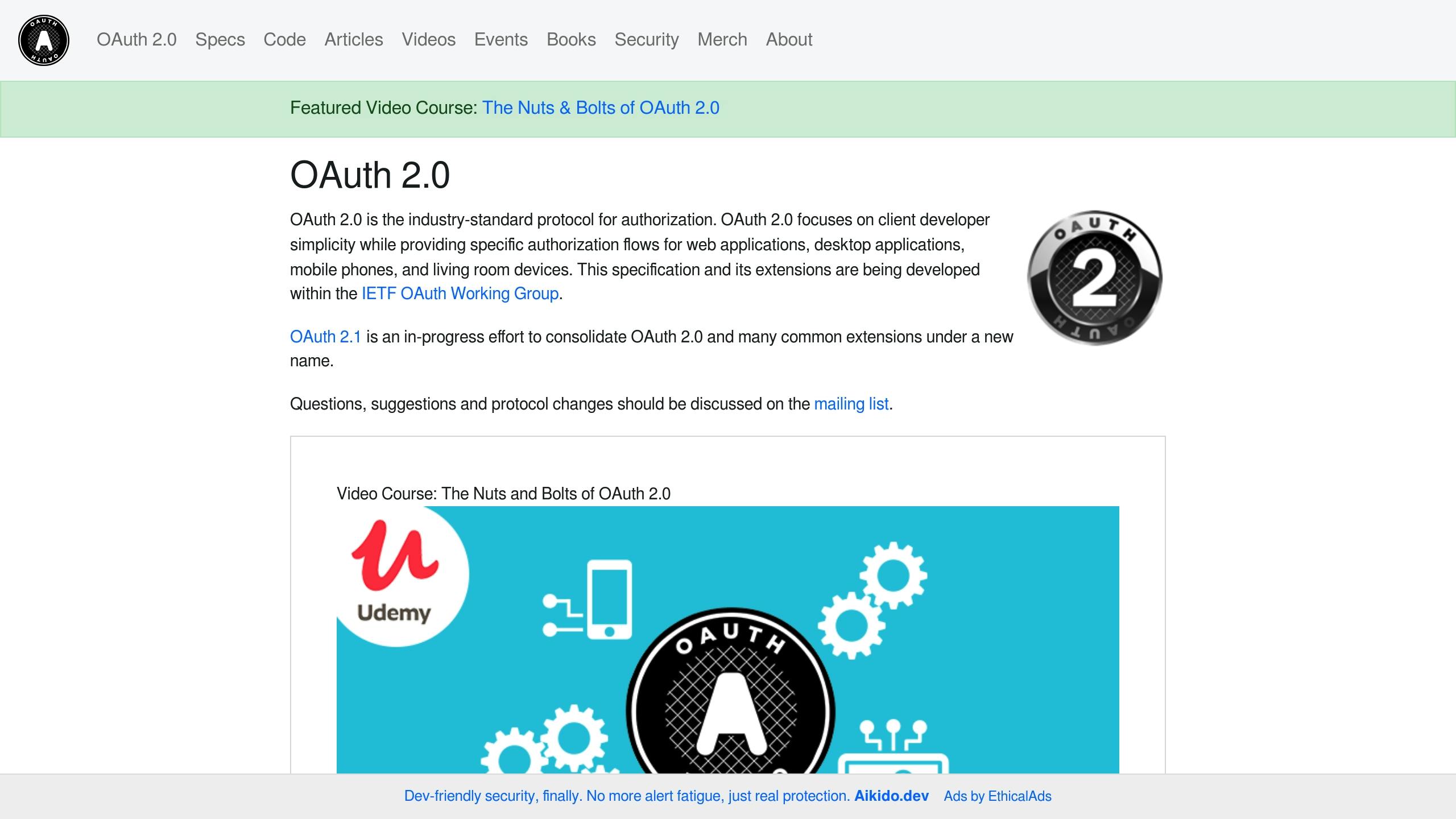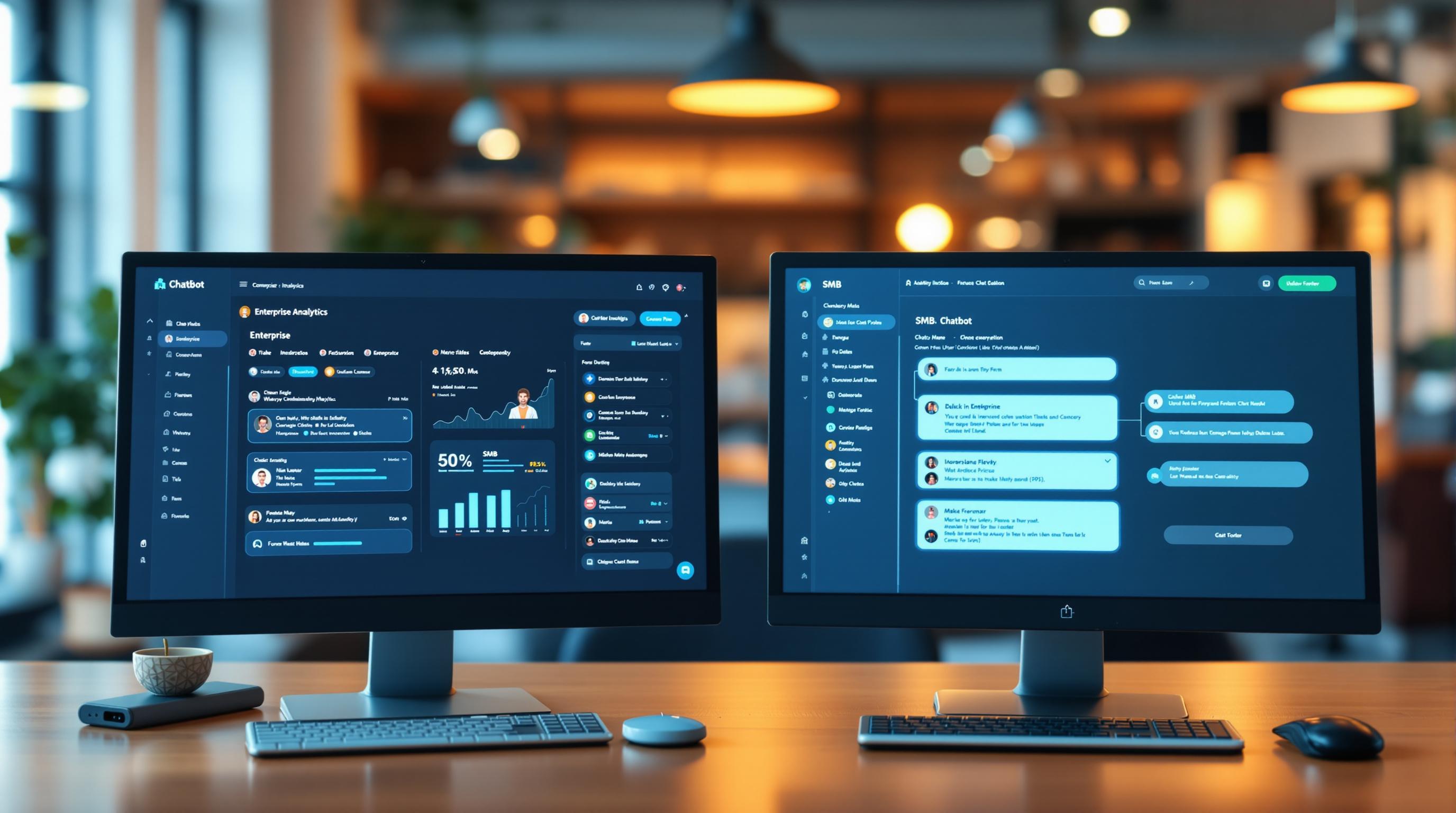Custom chatbot APIs are powerful tools for automating tasks and improving user interactions. But they can also expose sensitive data and systems to risks like data breaches, unauthorized access, and service disruptions. To protect your chatbot APIs, focus on these 9 essential security tips:
- Strong Authentication: Use API keys, OAuth 2.0, multi-factor authentication, and secure token practices.
- Data Encryption: Encrypt data in transit (TLS 1.3) and at rest, and securely manage encryption keys.
- Input Validation: Prevent attacks like SQL injection by validating and sanitizing all input data.
- Rate Limiting: Set request limits to avoid abuse and maintain API performance.
- Activity Monitoring: Log and track API activity to detect threats and ensure compliance.
- Access Control: Define user roles and permissions with Role-Based Access Control (RBAC).
- External API Security: Vet third-party APIs, protect credentials, and monitor integrations.
- Regular Security Testing: Run automated scans, penetration tests, and fuzz testing.
- Software Updates: Keep API software and dependencies up to date to patch vulnerabilities.
API Security: Best Practices
1. Set Up Strong API Authentication
Securing API authentication is essential to prevent unauthorized access and safeguard sensitive data.
API Keys and Access Tokens
Make sure your API keys or access tokens meet these criteria:
- At least 32 characters long, combining letters, numbers, and symbols.
- Set to expire within 30-90 days.
- Can be revoked immediately if compromised.
OAuth 2.0

Implement OAuth 2.0 for:
- Secure token handling.
- Detailed permission control.
- Compatibility with third-party integrations.
Multi-Factor Authentication (MFA)
For administrative API access, require MFA methods such as:
- Time-based one-time passwords (TOTP).
- Verification codes sent via SMS.
- Hardware security keys.
- Biometric options like fingerprints or facial recognition.
Best Practices for JSON Web Tokens (JWT)
When using JWTs, follow these guidelines:
- Set token expiration between 15-60 minutes.
- Opt for strong signing algorithms like RS256 or ES256.
- Keep the payload minimal to reduce exposure.
- Regularly rotate tokens to maintain security.
Security Headers
Configure these headers to enhance security:
Authorization: Use the Bearer token format.X-API-Key: Include a custom API key header.WWW-Authenticate: Enable a challenge-response mechanism.Strict-Transport-Security: Enforce HTTPS connections.
These steps provide a solid foundation for protecting your APIs and are crucial for the additional security measures covered later.
2. Use Data Encryption
Protect your data both during transfer and while it's stored. These encryption methods work alongside the authentication steps you’ve already put in place.
Transport Layer Security (TLS)
To secure data in transit, enforce TLS 1.3 or higher. Configure endpoints with:
- Strong cipher suites like AES-256-GCM
- Perfect Forward Secrecy through ECDHE key exchange
- Automatic HTTPS enforcement using 301 redirects
Encrypting Data at Rest
Stored data needs strong encryption to stay secure. Follow these steps:
- Use field-level encryption for databases
- Keep encryption keys separate from the data
- Enable disk-level encryption
- Regularly update and rotate encryption keys
Payload Encryption
For sensitive message payloads, use these methods:
- End-to-end encryption: Encrypt messages before sending them
- Message-level security: Use standards like JSON Web Encryption (JWE) for API responses
- Secure key exchange with asymmetric encryption
- Mask or encrypt personal data like PII through data masking
Key Encryption Tips
- Store keys securely using hardware security modules (HSMs)
- Use secure key derivation functions like PBKDF2 or Argon2 if passwords are involved
- Ensure all cryptographic operations rely on a secure source of randomness
3. Check and Clean Input Data
Making sure your chatbot API handles input data securely is a must. Validating and cleaning inputs can help block threats like SQL injection and cross-site scripting (XSS).
Input Validation Strategies
Before processing any data through your API, ensure it meets strict validation rules. Here's how:
- Type checking: Make sure the data matches expected types.
- Length constraints: Set minimum and maximum lengths for inputs.
- Regular expressions: Use them to validate data patterns.
- Range checks: Verify numerical values fall within acceptable limits.
Data Sanitization Methods
Once inputs are validated, sanitize them to remove harmful elements:
- HTML encoding: Convert special characters into their HTML-safe equivalents.
- SQL escaping: Properly escape database queries to block SQL injection.
- Unicode normalization: Standardize Unicode and remove unnecessary whitespace.
- Whitespace handling: Trim extra spaces and normalize line endings.
Parameterized Queries
Never directly concatenate user input into your queries. Instead:
- Use prepared statements with parameterized queries.
- Leverage Object-Relational Mapping (ORM) tools to handle data securely.
- Bind input data separately from query logic.
- Ensure your database driver supports query parameterization.
Adding strict header policies can further strengthen your API's security.
Content Security Headers
Secure your API endpoints with these HTTP headers:
Content-Security-Policy: default-src 'self'
X-Content-Type-Options: nosniff
X-Frame-Options: DENY
X-XSS-Protection: 1; mode=block
Character Encoding
Consistent character encoding is crucial to prevent mishandling of data:
- Set UTF-8 as the default encoding.
- Check character sets before processing.
- Encode or strip out potentially harmful characters.
- Use Base64 encoding for binary data when needed.
4. Add Request Rate Limits
Rate limiting is a key tool to protect your chatbot API from misuse and to maintain steady performance. After implementing authentication, encryption, and input validation, rate limiting adds another layer to ensure your API stays reliable.
Rate Limiting Strategies
Here are a few common methods for controlling request rates:
- Token bucket: Allows short bursts of requests while keeping an average limit.
- Fixed window: Tracks requests within set time intervals.
- Sliding window: Monitors requests across overlapping time periods.
- Concurrent requests: Limits the number of simultaneous connections.
Implementation Guidelines
Define specific rate limits for each API endpoint. For example:
# Example Rate Limit Configuration
POST /api/chat: 60 requests per minute
GET /api/status: 120 requests per minute
POST /api/analyze: 30 requests per minute
These limits should align with your broader security measures.
Response Headers
Include headers in your API responses to inform users about rate limits:
X-RateLimit-Limit: 60
X-RateLimit-Remaining: 45
X-RateLimit-Reset: 1716321600
Retry-After: 120
Tiered Rate Limiting
Tailor rate limits to different user tiers to balance usage and performance:
| Tier | Requests/Min | Daily | Burst |
|---|---|---|---|
| Free | 30 | 1,000 | 50 |
| Pro | 120 | 5,000 | 200 |
| Enterprise | 300 | 15,000 | 500 |
Rate Limit Response
When a user exceeds the limit, return an HTTP 429 (Too Many Requests) response with clear details:
{
"error": "rate_limit_exceeded",
"message": "Request limit reached. Please retry in 120 seconds.",
"retry_after": 120
}
Best Practices
- Use Redis or similar in-memory databases to track request counts efficiently.
- Implement IP blocking and graceful fallback mechanisms for repeated violations.
- Clearly document rate limits in your API specifications.
- Regularly monitor usage patterns and adjust limits as needed.
Emergency Controls
Prepare for sudden spikes in traffic with these measures:
- Temporarily reduce limits by 50% during high traffic periods.
- Disable non-critical endpoints during attacks to protect core services.
- Auto-scale essential services to handle increased demand.
sbb-itb-2e73e88
5. Track API Activity
Keeping an eye on API activity helps identify potential threats and improve overall performance.
Key Details to Log
For every API request, make sure to log the following:
- Timestamp and how long the request took
- IP address and its location
- Authentication details
- Endpoint being accessed
- Payload size
- Status codes
- Error messages
- Resource usage
Once you've identified these elements, set up tools to record and store them effectively.
Setting Up Monitoring Tools
Here’s an example configuration for logging setup:
{
"logging": {
"level": "INFO",
"format": "json",
"retention": "30 days",
"storage": "encrypted",
"fields": [
"timestamp",
"request_id",
"user_id",
"endpoint",
"response_time",
"status_code"
]
}
}
Defining Security Alert Limits
Establish thresholds to trigger alerts and actions when unusual patterns occur:
| Event Type | Warning Threshold | Critical Threshold | Action |
|---|---|---|---|
| Failed Auth | 5/minute | 10/minute | Block IP |
| API Errors | 10/minute | 25/minute | Apply rate limit |
| Response Time | >500ms | >2000ms | Scale resources |
Using a Real-Time Dashboard
A real-time dashboard can make it easier to monitor your API. Track key metrics like:
- Active connections
- Success and failure rates for requests
- Authentication statuses
- Resource usage levels
- Geographic distribution of requests
- Trends in response times
Automating Responses to Threats
Automate actions to respond quickly when thresholds are crossed. For example:
{
"security_rules": {
"brute_force": {
"condition": "auth_failures > 10",
"action": "block_ip",
"duration": "24h"
},
"data_breach": {
"condition": "payload_size > 5MB",
"action": "suspend_access",
"alert": "high"
}
}
}
Managing Log Retention
Follow these best practices to secure and manage your logs:
- Encrypt logs when stored
- Retain logs for 30 days
- Rotate logs periodically
- Backup logs in a secure location
- Restrict access to authorized users
- Regularly review and analyze logs
Keeping Up with Compliance
Ensure your monitoring aligns with compliance requirements by checking:
- Data access patterns
- Adherence to privacy policies
- Authentication methods
- Data encryption status
- Changes to access controls
- Updates to security patches
6. Control User Access Levels
Managing API access effectively requires more than just authentication and monitoring. Defining clear roles and permissions is key to limiting exposure. Role-Based Access Control (RBAC) ensures that users only have access to what they need, protecting sensitive operations.
Define Access Roles
Assigning roles with specific access levels ensures users interact with APIs appropriately. Here's an example:
| Role | Access Level | Scope |
|---|---|---|
| Admin | Full | All endpoints and configurations |
| Developer | High | Testing endpoints and logs |
| Support | Medium | User data and conversation history |
| Basic User | Limited | Chat functionality only |
| Guest | Minimal | Public endpoints only |
Define Endpoint Permissions
Control permissions at the endpoint level to restrict actions based on roles. Here's a sample configuration:
{
"permissions": {
"chat": {
"read": ["basic_user", "support", "admin"],
"write": ["basic_user", "support", "admin"],
"delete": ["admin"]
},
"analytics": {
"read": ["support", "admin"],
"export": ["admin"]
},
"settings": {
"read": ["developer", "admin"],
"modify": ["admin"]
}
}
}
Set Up Access Hierarchies
Define a hierarchy to establish role relationships. Higher roles inherit permissions from lower ones:
{
"role_hierarchy": {
"admin": ["developer", "support", "basic_user", "guest"],
"developer": ["basic_user", "guest"],
"support": ["basic_user", "guest"],
"basic_user": ["guest"]
}
}
Implement Token-Based Authorization
Token-based systems, like JWT, are effective for managing user roles and permissions. Key steps include:
- Embedding role data in the token payload
- Validating tokens with every API request
- Maintaining revocation lists for compromised tokens
Add Context-Based Restrictions
Enhance security by applying restrictions based on context, such as:
- Time-based restrictions: Allow operations only during specific hours.
- IP whitelisting: Restrict admin access to approved IPs.
- Device fingerprinting: Verify actions from recognized devices.
- Geographic controls: Limit access based on user location.
- Behavior monitoring: Detect and flag unusual activity.
Audit Access Changes
Keep track of any changes to roles and permissions for accountability:
- Log role updates and denied access attempts.
- Record modifications to permissions.
- Monitor privilege escalations closely.
- Document updates to access policies.
Handle Access Delegation
Sometimes, temporary permission escalation is necessary. Here's a sample for managing delegated access:
{
"delegation_rules": {
"max_duration": "24h",
"requires_approval": true,
"notify_admins": true,
"log_level": "detailed",
"allowed_roles": ["support", "developer"]
}
}
This approach ensures that temporary access is controlled, monitored, and secure.
7. Check External API Security
When working with external APIs, it's crucial to extend your internal security practices to these integrations. Properly assessing and securing external services can help you avoid vulnerabilities introduced by third-party systems.
Evaluate Third-Party Security Standards
Before integrating any external API, review their security practices. Here's a breakdown of key aspects to evaluate:
| Security Aspect | Verification | Required Standard |
|---|---|---|
| Data Encryption | Documentation | TLS 1.3 or higher |
| Authentication | Security specifications | OAuth 2.0 or API Keys |
| Compliance | Certificates | SOC 2, ISO 27001 |
| Data Storage | Privacy policy | GDPR/CCPA compliance |
| Incident Response | SLA terms | Response time under 24 hours |
Set Up API Gateway Protection
An API gateway acts as a safeguard for your external integrations. Configure it to ensure secure communication and data handling:
{
"gateway_config": {
"request_validation": {
"schema_validation": true,
"payload_size_limit": "1MB",
"allowed_endpoints": ["api.service.com/*"]
},
"response_validation": {
"sanitize_output": true,
"max_response_time": "5s"
}
}
}
Protect API Keys and Credentials
External service credentials should be handled with care. Follow these best practices:
- Store API keys securely in environment variables or dedicated vaults.
- Rotate credentials every 30 to 90 days to minimize risks.
- Use different keys for development and production environments.
- Encrypt keys at rest with AES-256.
- Actively monitor key usage to detect unusual activity.
Prepare for Service Disruptions with Circuit Breakers
Service interruptions are inevitable, so it's wise to implement circuit breakers. These help maintain functionality during failures:
{
"circuit_breaker": {
"failure_threshold": 5,
"reset_timeout": "60s",
"fallback_response": {
"type": "cached_data",
"max_age": "1h"
}
}
}
Monitor External API Health
Regular monitoring ensures that your integrations remain reliable and secure:
- Automate health checks every 5 minutes to track response times and identify anomalies.
- Maintain detailed logs of all interactions with external APIs.
- Conduct weekly security audits to ensure ongoing compliance and security.
Secure Data in Transit
Protect data as it moves between systems. Use TLS 1.3, enforce HTTP Strict Transport Security (HSTS), and apply a strong Content Security Policy (CSP) to prevent interception or tampering.
Manage API Versioning
Keep track of API versions to avoid disruptions:
- Document dependencies on specific API versions.
- Test new versions in a staging environment before deploying.
- Maintain compatibility layers to support older versions.
- Clearly document version-specific security measures.
- Plan and execute migration strategies for deprecated versions.
8. Run Security Tests
Regular testing is essential to keep your API secure. By combining automated scans with manual penetration tests, you can uncover vulnerabilities and protect your API from potential threats.
Automated Security Scanning
Set up automated security scans to run continuously. Here's an example configuration:
{
"security_scan_config": {
"frequency": "daily",
"scan_types": [
"vulnerability_assessment",
"dependency_check",
"code_analysis"
],
"alert_threshold": "medium",
"automated_fixes": true
}
}
Penetration Testing Schedule
Use a structured approach for penetration testing to cover different aspects of your API's security:
| Test Type | Focus Areas | Documentation |
|---|---|---|
| Basic Scan | Input validation, authentication | Test results report |
| Deep Scan | Business logic, data exposure | Detailed findings |
| Full Audit | Infrastructure, integrations | Compliance report |
| Red Team | Advanced attack simulation | Strategic assessment |
API Fuzzing Implementation
Fuzz testing can help identify specific vulnerabilities like SQL injections and buffer overflows. Here's an example setup:
{
"fuzz_testing": {
"input_types": [
"SQL_injection",
"XSS_payloads",
"buffer_overflow",
"format_string"
],
"test_coverage": "90%",
"mutation_rate": 0.15
}
}
Security Test Automation
Integrate security testing into your CI/CD pipeline to streamline the process:
- Run detailed scans during deployments.
- Generate security reports for every release.
- Check dependencies for known vulnerabilities.
Response Time Testing
Evaluate API performance under attack. For instance, set a maximum response time of 200ms for up to 1,000 concurrent requests, with a 0.1% error rate and a 5-second timeout.
Security Regression Testing
Keep a record of past vulnerabilities and ensure they don't reappear by maintaining tests with clear reproduction steps and expected outcomes.
Load Testing Under Attack
Simulate high-load scenarios to test resilience. For example, combine a base traffic rate of 5,000 requests per second with DDOS, brute force, and injection attack simulations over a 30-minute period.
9. Update API Software
After conducting thorough security tests, make it a habit to keep your API software updated. Always test updates in a staging environment that closely resembles your production setup. This helps you avoid unexpected issues or security vulnerabilities during deployment.
Once updates are live, keep a close eye on API activity to quickly spot and address any problems. It's also wise to have a rollback plan in place, so you can return to a stable version if needed without delay.
Conclusion
Securing custom chatbot APIs is a must in today’s digital landscape. Combining layers of protection - like authentication, encryption, and continuous monitoring - can effectively guard against potential threats.
These security measures work together to protect vulnerable areas, such as preventing unauthorized access and maintaining system integrity. Here's how they contribute:
- Authentication and encryption safeguard sensitive data.
- Input validation and rate limiting prevent system overloads.
- Access control and activity tracking ensure proper usage.
- Regular testing and updates keep security measures current.
For developers looking for secure chatbot solutions, AI Chat List offers a helpful Ethics & Security section. It provides vetted AI tools and practical guidelines for implementation, making it easier to secure your APIs for the long haul.
Keeping your chatbot API secure requires regular assessments and updates. As new threats emerge, staying informed and proactive with these strategies will help maintain reliability and safety.


